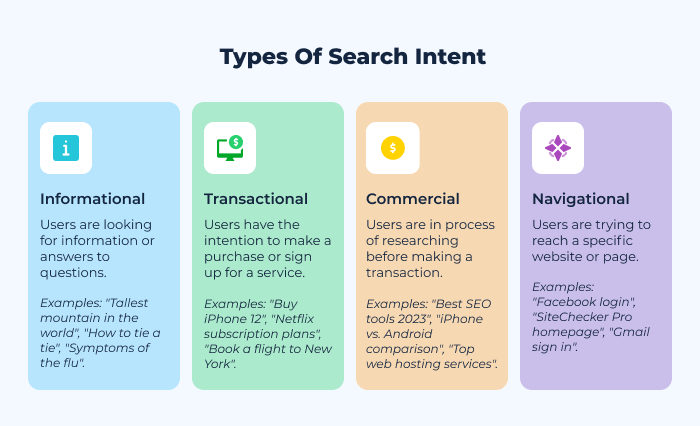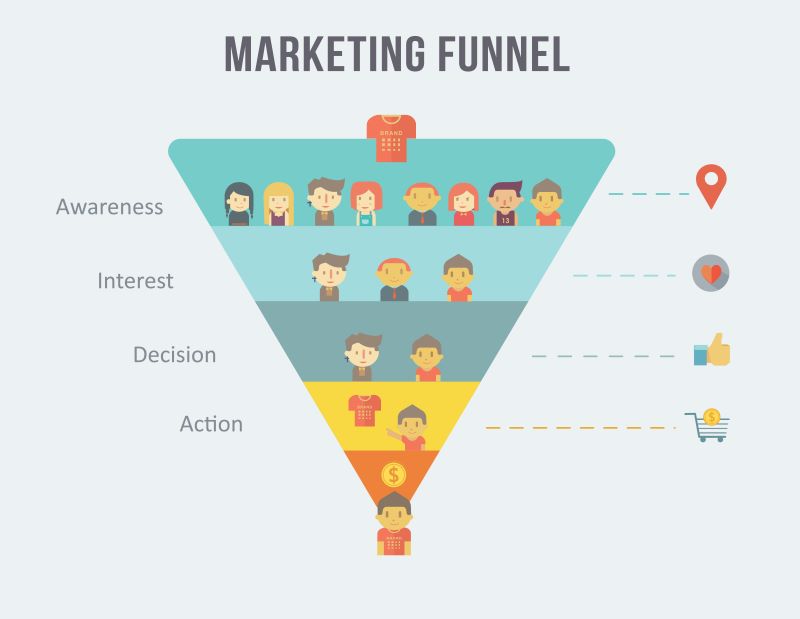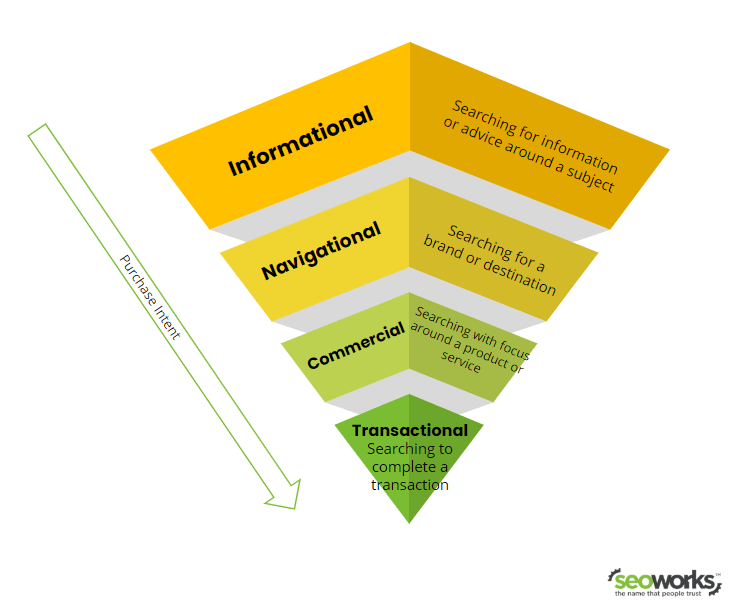Unlock the secrets of user intent and maximize your search traffic with strategies to target user queries effectively online.

Image courtesy of via DALL-E 3
Table of Contents
- Introduction: What is Search Intent?
- Types of Search Intent
- Informational Search Intent
- Navigational Search Intent
- Transactional Search Intent
- Commercial Search Intent
- How to Identify Search Intent
- Why Businesses Need to Understand Search Intent
- Conclusion: Wrapping Up Search Intent
- FAQs about Search Intent
Introduction: What is Search Intent?
When we use the internet to search for information, we often have a specific reason behind our searches. This reason is what we call search intent. Search intent is the purpose or motivation behind why someone types a query into a search engine like Google. Understanding search intent is crucial because it helps us find the right information we need faster.
Definition of Search Intent
Simply put, search intent is the reason why someone is searching for something online. It’s like figuring out why you ask a question. For example, if you’re looking for a recipe to make chocolate chip cookies, your search intent is to find a recipe so you can bake delicious cookies.
Importance of Search Intent
Knowing the search intent behind a query is essential because it helps us provide relevant and accurate information. When we understand why people are searching for something, we can tailor our content to meet their specific needs. This way, users can find the answers they’re looking for more quickly and easily.
Types of Search Intent
When you type something into a search engine, you have a specific goal in mind. This is what we call search intent. There are different types of search intent, each serving a different purpose. Let’s explore the various kinds of search intent to help you better understand how people search for information online.
Informational Search Intent
Informational search intent is when someone is looking to learn something or find answers to their questions. For example, when you search for ‘How to make slime’ or ‘What is a rainbow?’, you are displaying informational search intent. These searches are essential for acquiring knowledge and understanding various topics better.
Navigational Search Intent
Navigational search intent is used when you know which website you want to visit but don’t remember the exact web address. For instance, typing ‘YouTube’ into the search bar to directly access the YouTube website showcases navigational search intent. These searches help you quickly reach your desired online destination.
Transactional Search Intent
Transactional search intent comes into play when you intend to make a purchase. Searches like ‘buy LEGO set’ or ‘purchase movie tickets’ demonstrate transactional search intent. These searches are crucial for finding and buying products online.
Commercial Search Intent
Commercial search intent is utilized when comparing products or reading reviews before making a purchase decision. For example, searching ‘best smartphones 2023’ or ‘laptop reviews’ indicates commercial search intent. These searches assist in making informed choices by comparing different options.
Informational Search Intent
In the world of online search, when someone is seeking to learn something new, find answers to questions, or simply gather information, they are exhibiting what we call informational search intent.

Image courtesy of www.singlegrain.com via Google Images
Examples of Informational Searches
Imagine someone curious about how to make slime or inquiring about what exactly a rainbow is. These are the types of informational searches that people conduct to satisfy their thirst for knowledge.
Why Informational Searches Matter
Informational searches are crucial as they assist individuals in finding facts, learning new concepts, or gaining insights on various topics. They contribute to expanding our knowledge base and understanding the world around us.
Navigational Search Intent
Navigational search intent is when you are looking to find a specific website or webpage on the internet but may not remember the exact URL. It’s like having a destination in mind but not knowing the exact address. This type of search intent is useful when you want to quickly locate a particular website without typing in the full web address.
Examples of Navigational Searches
For example, if you want to visit YouTube, instead of typing the entire web address, you can simply type ‘YouTube’ in the search bar and click on the link that appears at the top of the search results. Similarly, if you want to go to the official website of a company or an online store, you can search for their name and easily navigate to their site.
Why Navigational Searches Matter
Navigational searches are important because they help you quickly reach your desired website or webpage without the need to remember or type in the complete URL. It saves time and effort by allowing you to find the information or platform you are looking for with just a few clicks. Understanding how to use navigational search intent can make your online browsing experience more convenient and efficient.
Transactional Search Intent
Transactional search intent is when someone is looking to make a purchase or buy something online. It’s like going to a store with the intention of buying a specific product. People use transactional searches when they are ready to make a purchase and are looking for the best deal or product that meets their needs.

Image courtesy of sitechecker.pro via Google Images
Examples of Transactional Searches
Some examples of transactional searches include queries like ‘buy LEGO set’ or ‘purchase movie tickets’. These searches clearly indicate that the user is in the mindset of making a transaction and is looking for opportunities to buy.
Why Transactional Searches Matter
Understanding transactional searches is crucial for businesses because it helps them connect with potential customers who are ready to make a purchase. By targeting transactional keywords and optimizing their website for these searches, businesses can increase the chances of attracting buyers and generating sales.
Commercial Search Intent
Commercial search intent is when people use the internet to compare products, read reviews, and gather information before making a purchase. This type of search intent is important for consumers who want to make informed buying decisions.
Examples of Commercial Searches
Some examples of commercial searches include queries like ‘best smartphones 2023’ or ‘laptop reviews’. These searches show that users are looking for information to help them make a purchasing decision.
Why Commercial Searches Matter
Commercial searches matter because they help people make better choices by comparing products, reading reviews, and finding the best deals. Understanding commercial search intent can also help businesses tailor their marketing strategies to attract potential customers.
How to Identify Search Intent
Analysing user queries is crucial to understanding what people are looking for when they search online. By identifying search intent, you can tailor your content to meet the needs of your audience more effectively. Here are some techniques to help you determine search intent:

Image courtesy of www.clickcease.com via Google Images
Analyzing Keywords
One way to identify search intent is by paying attention to the specific keywords used in the query. Certain words or phrases can indicate whether the user is looking for information, trying to make a purchase, or simply trying to navigate to a specific website. For example, words like “how-to” or “buy” can signify different intentions behind the search.
Understanding Context
Another method to identify search intent is by looking at the context surrounding the search query. Consider the user’s previous searches, location, device used, and even the time of day. By understanding the context in which the search is made, you can better interpret the intent behind it. For instance, if a user is searching for “best hiking boots” while in a specific location, it may suggest they are looking to make a purchase near them.
Why Businesses Need to Understand Search Intent
In the vast world of the internet, businesses need to understand what people are searching for in order to reach the right audience. Imagine you have a store that sells delicious chocolate chip cookies, but if you don’t know that people are searching for “best chocolate chip cookie recipe” online, you might miss out on attracting potential customers to your website. By understanding search intent, businesses can tailor their content to match what people are looking for, thus connecting with the right audience who are interested in what they have to offer.
Improving Search Rankings
Search engines like Google use complex algorithms to decide which websites show up first when someone searches for something. If a business doesn’t take search intent into account when creating content for their website, they might miss the mark and end up buried in the depths of search results where no one can find them. By aligning their content with the intent behind user searches, businesses can improve their search rankings and have a better chance of appearing on the coveted first page of Google results. This means more visibility and more potential customers finding their way to the business’s website.
Conclusion: Wrapping Up Search Intent
Understanding search intent is crucial when it comes to navigating the vast world of online information. By delving deeper into the reasons behind why people search for specific content, we can tailor our online experience to provide users with exactly what they are looking for. Let’s recap the key points we’ve covered about search intent.

Image courtesy of www.seoworks.co.uk via Google Images
Summary of Search Intent
Search intent refers to the purpose behind a user’s search query. It helps search engines like Google provide the most relevant results to fulfill the user’s needs. By categorizing search intent into different types such as informational, navigational, transactional, and commercial, we can better understand what users are looking for and tailor our content accordingly.
Main Takeaways
When it comes to search intent, the main takeaway is that by aligning your content with what users are searching for, you can improve your website’s visibility and rankings on search engines. Identifying and targeting search intent allows businesses to reach their target audience more effectively and provide users with the information they are seeking.
As you continue to explore the world of online searches, remember to pay attention to the intent behind the keywords and queries. By understanding search intent, you can optimize your website to better serve users and enhance their online experience.
FAQs about Search Intent
What is the difference between the types of search intent?
Search intent can be categorized into four main types: informational, navigational, transactional, and commercial. Informational intent is when someone is looking for answers or trying to learn something new. Navigational intent is used to find a specific website without knowing the exact URL. Transactional intent is geared towards purchasing or buying something, while commercial intent involves comparing products or reading reviews before making a decision.
Can search intent change?
Yes, search intent can change based on user needs and preferences. As search engines evolve and users’ search behaviors shift, search intent may also adapt. It’s essential to stay updated with these changes to ensure your content aligns with the current search intent of your target audience.
How can I use search intent for my website?
To optimize your website for search intent, start by understanding the different types of search intent and aligning your content accordingly. Tailor your website content to match the specific intent behind user queries. For example, if your target audience is looking for information, create informative and educational content. If they are seeking to make a purchase, ensure your website offers clear and easy-to-find product or service information.







